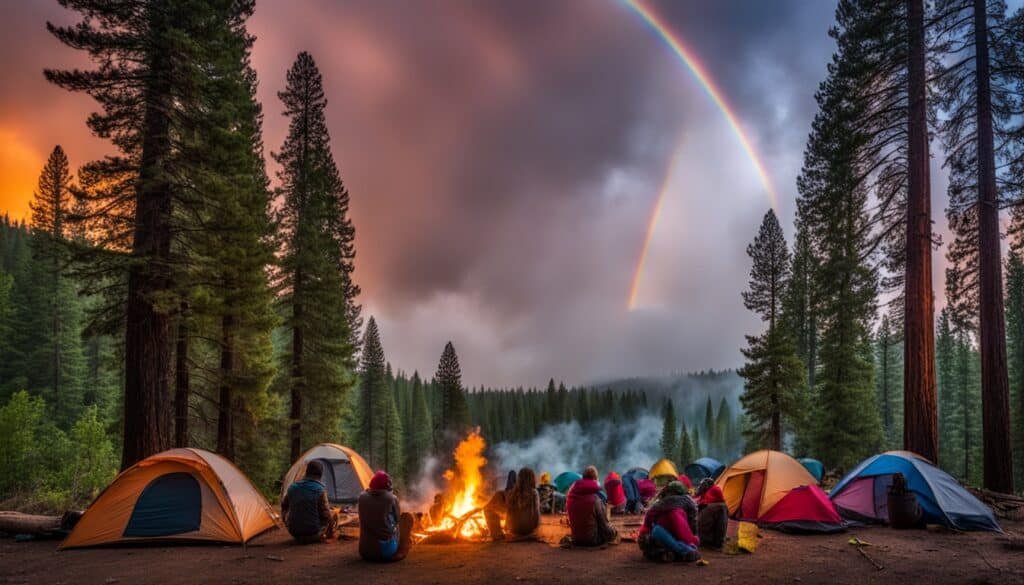California Forest: The U.S. Forest Service has told the Rainbow Family to leave the Plumas National Forest in northern California in 48 hours. They are worried about public safety, the environment, and fire risks. If people don’t leave, they could get fines up to $5,000 and even six months in jail.
Key Takeaways
- U.S. Forest Service has ordered the Rainbow Family to leave the Plumas National Forest in northern California within 48 hours.
- Authorities cited concerns over public safety, environmental impact, and fire risk as reasons for the forest closure.
- Individuals who refuse to comply face fines of up to $5,000 and up to six months in jail.
- The annual Rainbow Family gathering has a history of controversy and challenges in various communities.
- The decision to close the forest highlights the ongoing tensions between the Rainbow Family’s traditions and the concerns of local authorities.
Peaceful Gathering Disrupted in Plumas National Forest
The Plumas National Forest in Northern California is a spot where the Rainbow Family holds their annual gathering. This event draws between 5,000 and 10,000 people. But, this year, it’s facing strong opposition from local authorities and Native American tribes.
They worry about the event’s impact on the environment.
The Rainbow Family’s Annual Event Faces Opposition
Officials in the Plumas National Forest are worried about the event’s effects. They fear more traffic, environmental harm, and safety issues. Despite efforts by the event’s organizers, local opposition is still strong.
Local Tribes Voice Concerns Over Location Choice
Four Native American tribes, including the Mountain Maidu, Paiute, Pit River, and Washoe, have spoken out. They urge the Rainbow Family to pick a different spot for their gathering. They’re worried about sacred sites and the forest’s ecosystem.
The debate between the Rainbow Family, local authorities, and Native American tribes is growing. The future of the gathering is still up in the air. Both sides are standing firm in their beliefs.
“We have deep concerns about the impact this large gathering will have on our sacred sites and the natural environment of the Plumas National Forest,” said a spokesperson for the Mountain Maidu tribe.
The Rainbow Family: A Tradition of Counterculture
The Rainbow Family of Living Light is a counterculture movement. They meet every year in different national forests. They celebrate their unique lifestyle and values.
Starting in 1972, their annual event has become a tradition. Thousands from various backgrounds come together. They pray for peace and live off the grid in a communal way.
Origins and History of the Annual Gathering
The Rainbow Family started in the 1960s and 1970s counterculture. They were inspired by the hippie movement and wanted a nature-focused life. Their first gathering was in 1972 on National Forest land.
Over time, these events have become a tradition. Every Fourth of July, they meet in a different forest. They celebrate their counterculture and annual tradition.
The Rainbow Family is known for its strong community and beliefs. They call themselves the “largest non-organization of non-members in the world.” They come together without leaders or rules to live their counterculture lifestyle.
“We are not an organization, we have no leaders, we have no membership, we have no rules, we have no dues. We’re the largest non-organization of non-members in the world.”
The Rainbow Family’s gatherings have caused both celebration and controversy. Their large presence in national forests without permits has led to conflicts with authorities.
| Year | Location | Estimated Attendance |
|---|---|---|
| 1972 | Colorado | 20,000 |
| 1980 | Wyoming | 30,000 |
| 1990 | Arizona | 40,000 |
| 2000 | Oregon | 50,000 |
| 2010 | New Mexico | 60,000 |
Concerns Raised by Local Authorities
The Rainbow Family’s annual gathering in the Plumas National Forest has caused big worries for local authorities. They worry about public safety and the environmental impact. These concerns are about how the event might affect the area.
Public Safety and Environmental Impact Issues
The Plumas County Sheriff’s Office is worried about more crime, harm to the environment, and abandoned cars. They say the Rainbow Family won’t get the needed permits. This could overload the area’s resources and harm nature.
“This gathering has the potential to create significant public safety and environmental issues for our community,” said Sheriff Todd Johns. “We’re simply not equipped to handle the sheer number of people and the impact it will have on our local resources.”
There’s also fear of wildfires because the event happens during the peak fire season. Authorities are scared that more people and campfires could start a big fire. The area is dry and full of trees, making it a high-risk zone.
- Increased criminal activity
- Environmental damage to the Plumas National Forest
- Abandoned vehicles and infrastructure strain
- Wildfire risk during the region’s fire season
Because of these public safety issues and environmental impact worries, local authorities have taken steps. They’ve closed off the area and warned of fines and legal trouble for those who don’t listen.
California Forest Closure Order Issued

The U.S. Forest Service has issued a closure order for Plumas National Forest due to concerns. About 500 campers must leave within 48 hours. No one else can enter the closed forest area.
The plumas national forest closure addresses public safety and environmental worries. Local tribes worry about the gathering’s impact on nature and cultural sites.
The forest service closure order aims to manage the Rainbow Family’s presence. Authorities are watching closely. This step is to protect the land and its resources.
| Key Details of the Closure Order | Enforcement and Penalties |
|---|---|
|
|
This plumas national forest closure order is a big step in managing the Rainbow Family’s gathering. It shows the commitment to public safety and protecting the forest.
The forest service closure order highlights the complex issues around the Rainbow Family’s gatherings. Finding a balance between tradition and community needs is a big challenge.
Penalties for Non-Compliance

The U.S. Forest Service has issued a strict closure order for the Plumas National Forest. Those who don’t leave or try to enter the closed area face big fines and even jail time.
Fines and Potential Jail Time for Trespassing
Refusing to leave or entering the closed area without permission can lead to trespassing charges. You could get fines up to $5,000 and up to six months in jail. The Forest Service is serious about keeping the forest safe during this time.
Only locals and those with special permits can go into the closed part of the Plumas National Forest. Anyone else caught there might face penalties for non-compliance, including fines and jail time for trespassing.
“The closure order is necessary to protect public safety and the environment during this event,” stated a spokesperson for the U.S. Forest Service. “We urge everyone to comply with the order and avoid any potential legal consequences.”
The Rainbow Family gathering has always been a topic of debate. The latest closure order shows the authorities’ strong stance on the matter. As the event gets closer, the risks of non-compliance are clear, warning those thinking of ignoring the order.
Reactions from Locals and Officials

The decision to shut down the Rainbow Family gathering in the Plumas National Forest has caused mixed feelings. Some locals and officials support the move. Others worry about the increased police and how the Rainbow Family is treated.
Plumas County Supervisor Jason Ingram backs the closure. He says it tackles issues like legality, fire risk, and environmental harm. Ingram wants to protect the Plumas National Forest and keep everyone safe.
“This gathering is illegal, and it poses a significant threat to the environment and the well-being of our community. We have a responsibility to take action and prevent further damage to this precious natural resource.”
But, the Rainbow Family members see things differently. They feel harassed by the police and think their event is peaceful. They believe it’s a tradition that values everyone, self-sufficiency, and caring for nature.
The debate shows the tension between the Rainbow Family’s desire for a free event and the authorities’ need for safety and nature protection. Both sides will keep sharing their views and fighting for what they believe in.
The Rainbow Family’s Response
The Rainbow Family was told to leave the Plumas National Forest in Northern California. They strongly defend their annual event as a peaceful tradition. It’s about community and prayer. Adam Buxbaum, a spokesperson, has been going since he was a kid. He says the group lets people express themselves as long as they don’t hurt others.
The Rainbow Family calls their event a gathering, not a festival. It’s for people who share similar beliefs to come together. They use it to connect with nature, practice their beliefs, and feel united with others.
Defending Their Traditions and Beliefs
The Rainbow Family is standing up for their traditions and beliefs. They see their gathering as key to who they are. It’s a time to show they support non-violence, taking care of the environment, and being free.
“We believe in allowing people to express themselves as long as they are not harming others,” said Buxbaum. “This gathering is not an organized festival, but a coming together of like-minded individuals who share a way of life.”
The Rainbow Family wants to keep their event in the Plumas National Forest. They’re fighting for their tradition and believe it’s crucial to their community.
The standoff between the Rainbow Family and the authorities is ongoing. The group’s response and defense of their traditions and beliefs will greatly influence the outcome.
Also Read: Highlights And Heartbreak: Winners And Losers Of The First Four Days At The Us Olympic Track And Fie
Past Controversies and Challenges
The Rainbow Family gatherings have seen their share of controversy and challenges. These events often upset local authorities and communities. They worry about public health, environmental effects, and the strain on local resources.
In 2013, a Rainbow Family event in Montana cost the U.S. Forest Service $573,000 to manage and watch over. Local tribes and officials have expressed concerns about the group ignoring permits. They also worry about the negative effects their events have on the land and nearby communities.
Despite these ongoing issues, the Rainbow Family stays true to their tradition of peaceful gatherings. Yet, the effect on local communities keeps causing tension and debate.
FAQs
Q: Why are the Rainbow Family being ordered to leave the Northern California forest?
A: The authorities are ordering the Rainbow Family to leave the forest due to concerns over fire threats and risks associated with their presence.
Q: How are local fire agencies such as Cal Fire involved in this situation?
A: Local fire agencies such as Cal Fire are closely monitoring the situation to ensure the safety of the community and to prevent any potential wildfires.
Q: What measures are the forestry departments taking to address the wildfire risks?
A: The forestry departments are implementing strategies such as fuel management, landscape resilience planning, and ongoing updates to mitigate the fire threats in the area.
Q: What is the significance of the 2024 deadline mentioned in relation to the forest management?
A: The 2024 deadline signifies the urgency to improve forest health and resilience before that year to prevent catastrophic wildfires.
Q: How can the community contribute to forest health and fire prevention efforts?
A: The community can support initiatives by organizations like the California Forest Foundation and participate in vegetation management programs to enhance forest resilience.
Q: Where can I find updated information about the forest situation in Northern California?
A: For the most recent updates and information, visit the official California government website dedicated to woodland and forest management.
Q: What are some of the key organizations involved in managing California’s forests?
A: Organizations such as the US Forest Service, Bureau of Land Management, and National Park Service play crucial roles in overseeing California’s forest ecosystems and ensuring their health.
Source Links
- https://sfist.com/2024/06/27/rainbow-family-gathering-ordered-out-of-national-forest-for-first-time-threatened-with-fines/
- https://nypost.com/2024/06/27/us-news/rainbow-family-ordered-to-leave-plumas-national-forest-or-face-fines/
- https://theashlandchronicle.com/the-rainbow-family-gathering-is-happening-in-a-northern-california-forest-and-locals-are-freaking-out/




